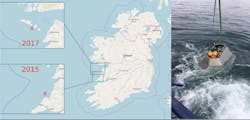Georgia Institute of Technology — Massive storms cause massive damage. Winds down trees and power lines, and rain and storm tides flood streets. Coastlines often take the brunt of a storm's force, with giant waves eroding the shore and causing widespread damage. Seawalls, seaports, and other structures and methods designed to protect coastlines from erosion and flooding must not only withstand standard wave force but storm tides, and to do that, we need to understand their destructive potential. To that end, an international team of researchers has analyzed months of data on large nearshore waves with hopes that the insights gathered can help design better protections to lessen the impact of large storm waves on coastlines.
The study, published October 28 in the journal Scientific Reports, combines a mathematical model used to describe the formation of large waves and real-world measurements taken in shallow waters off the coast of Ireland. There, waves have been reported to hit the shore with enough force to move 100-ton rocks. Francesco Fedele, associate professor at Georgia Tech School of Civil and Environmental Engineering, says the data gathered and analyzed from measuring storm events over several months shows that there are similarities in cause and shape between extreme storm waves and rogue waves found in deep water, although the former tend to be smaller, on average.
"These large nearshore waves are still caused by constructive interference—the effect of waves coming in all different directions and basically meeting at one point and piling up to form a large wave, and by second-order nonlinearities that distort the sinusoidal shape of waves to have sharper crests and shallower troughs," says Fedele.
The research team also included M. Aziz Tayfun, professor emeritus from Kuwait University, Frederic Dias, a professor at the University College Dublin, and James Herterich, a postdoctoral associate, also at the University College Dublin.
The study used data gathered by an acoustic doppler current profiler device (ADCP) on the ocean floor off Killard point in the Spring of 2015 and of the Aran Islands in the Spring of 2017. The study, which was sponsored by Science Foundation Ireland, used data captured from two intense storms that produced large coastal waves during that time. Doris, which hit the Irish coast in February 2017, produced waves as high as 43 feet from peak to trough. The ADCP recorded waves as high as 73 feet during the unnamed 2015 storm. The ADCP emits sound pulses and measures the strength of the sounds which bounce off of floating particles in order to calculate the height of the waves.
Researchers then compared that data with statistical models that explain rogue waves found deep water.
"We were able to extend these statistical models, which are largely validated for waves in deep waters, to describe coastal rogue waves," says Fedele.
The comparison showed a similar profile for all the waves, which suggests that nearshore waves are generated in a similar way to the deep water rogue waves, Fedele says. For nearshore waves, though, the wave breaking bleeds away some of their energy.
"A lot of the energy is dissipated forming white caps that crash against the shore," says Fedele.
The research could provide valuable data to improve the designs of coastal structures, which should be built to withstand the force of storms over time. For those implementing coastal protection, knowing how waves form and break in coastal areas and being able to better predict the likelihood of extreme waves during storms can help to minimize erosion and damage to coastal communities and infrastructure.
For more information on the study, visit Georgia Tech's website. The study can be read online here.






